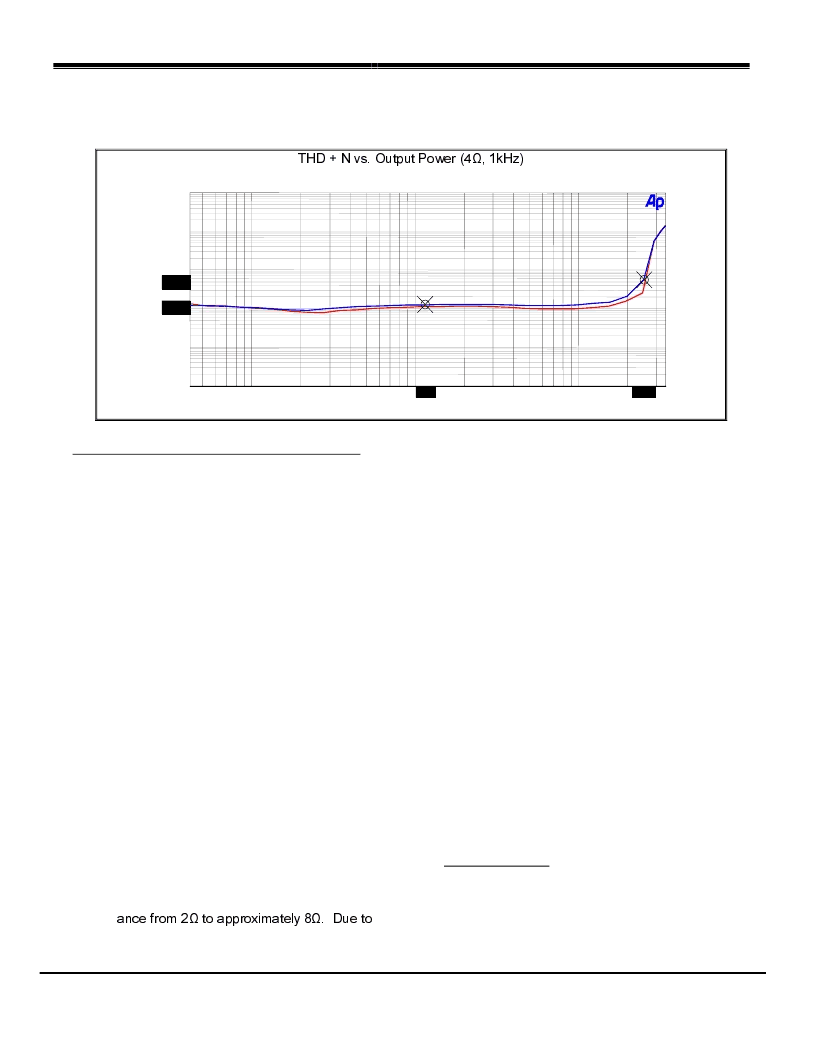- 您現(xiàn)在的位置:買賣IC網(wǎng) > PDF目錄375782 > FDS6612A (Microsemi Corporation) EVALUATION KIT PDF資料下載
參數(shù)資料
| 型號: | FDS6612A |
| 廠商: | Microsemi Corporation |
| 英文描述: | EVALUATION KIT |
| 中文描述: | 評估板 |
| 文件頁數(shù): | 9/18頁 |
| 文件大?。?/td> | 339K |
| 代理商: | FDS6612A |

LXE1710 E
VALUATION
B
OARD
U
SER
G
UIDE
Microsemi
Linfinity Microelectronics Division
11861 Western Avenue, Garden Grove, CA. 92841, 714-898-8121, Fax: 714-893-2570
Page 9
Copyright
2000
Rev. 1.1, 2000-12-01
A
PPLICATION
I
NFORMATION
! &' (
LX1710 Filter Implementation, 1-stage vs. 2- stage
0.001
100
50
0.002
0.005
0.01
0.02
0.05
0.2
1
2
5
10
20
0.55626
0.12572
P
50m
30
100m
200m
500m
1
2
5
10
20
25.04
1.15
Watts(W)
2-Stage
1-Stage
F
ILTER
D
ESIGN
T
RADEOFFS
(1-
STAGE VS
. 2-
STAGE
)
A 1-stage or 2-stage filter may be used depending on
your application and performance targets. The main
tradeoff in this selection is price (number of
components, component costs, PCB area) vs.
performance. The primary advantage of the single
stage filter is lower cost whereas the main benefit to a
2-stage filter is that it will provide steeper attenuation.
This allows the corner frequency to be selected further
outside of the audio band (to minimize the effects of
impedance variations in the passband) and still
provide adequate RF attenuation.
Single Stage Filter Advantages
Low Cost: The 1-stage LC filter uses one half
the number of inductors/capacitors resulting in
a substantial cost savings over a 2-stage
design. Key parameters such as THD+N,
frequency response, and nose performance
do not change significantly.
Power Loss: Since current will flow in two
inductors and not four, the inductor power loss
will be less in the single stage design. The
overall amplifier will have a wider dynamic
range and improved efficiency.
Filter Design: This easy-to-design filter can
limit audio signal changes within +/- 3dB
across the audio band with impedance
vari
" ) *+ ,!
a steeper rolloff with the 2-stage filter,
impedance changes could result in a +/- 6dB
change.
THD: There are minimal differences between
the 1-stage and 2-stage implementations with
other parameters such as THD+N as seen in
the above graph.
Single Stage Filter Disadvantages
EMI and Switching Frequency: For the 1-
stage, the switching frequency must be higher
than 400kHz to ensure the corner frequency
will provide adequate amplifier performance in
the high end of the audio frequency range. If
f
S
< 400kHz, then
f
C
<
f
S
/10 = 40kHz which is
too close to the desired audio band. A higher
oscillation frequency could translate into
greater MOSFET switching losses, slightly
lower efficiency, and increased EMI effects.
With a 2-stage 4th order filter, the switching
frequency
f
S
can be reduced to 120kHz. If
f
S
=
120kHz, then
f
C
=
f
S
/3 = 40kHz. The lower
oscillation frequency could help minimize EMI
issues.
LC F
ILTER
D
ESIGN
The output filter helps to reconstruct the amplified
audio signal and filter out the switching frequency.
The design of the filter depends on the type of
attenuation and frequency response desired at the
output. The output filter designed into the LXE1710
相關(guān)PDF資料 |
PDF描述 |
|---|---|
| FDS4953 | Dual P-Channel, Logic Level, PowerTrenchTM MOSFET |
| FDS6612A | Single N-Channel, Logic Level, PowerTrenchTM MOSFET |
| FDS5170N7 | 60V N-Channel PowerTrench MOSFET |
| FDS5670 | 60V N-Channel PowerTrench⑩ MOSFET |
| FDS5672 | N-Channel PowerTrench MOSFET |
相關(guān)代理商/技術(shù)參數(shù) |
參數(shù)描述 |
|---|---|
| FDS6612A | 制造商:Fairchild Semiconductor Corporation 功能描述:SO8 SINGLE NCH :ROHS COMPLIANT |
| FDS6612A_03 | 制造商:FAIRCHILD 制造商全稱:Fairchild Semiconductor 功能描述:Single N-Channel, Logic-Level, PowerTrench MOSFET |
| FDS6612A_D84Z | 功能描述:MOSFET Single N-Ch LL Power Trench RoHS:否 制造商:STMicroelectronics 晶體管極性:N-Channel 汲極/源極擊穿電壓:650 V 閘/源擊穿電壓:25 V 漏極連續(xù)電流:130 A 電阻汲極/源極 RDS(導(dǎo)通):0.014 Ohms 配置:Single 最大工作溫度: 安裝風(fēng)格:Through Hole 封裝 / 箱體:Max247 封裝:Tube |
| FDS6612A_Q | 功能描述:MOSFET SO-8 N-CH 30V RoHS:否 制造商:STMicroelectronics 晶體管極性:N-Channel 汲極/源極擊穿電壓:650 V 閘/源擊穿電壓:25 V 漏極連續(xù)電流:130 A 電阻汲極/源極 RDS(導(dǎo)通):0.014 Ohms 配置:Single 最大工作溫度: 安裝風(fēng)格:Through Hole 封裝 / 箱體:Max247 封裝:Tube |
| FDS6614A | 功能描述:MOSFET SO-8 N-CH 30V RoHS:否 制造商:STMicroelectronics 晶體管極性:N-Channel 汲極/源極擊穿電壓:650 V 閘/源擊穿電壓:25 V 漏極連續(xù)電流:130 A 電阻汲極/源極 RDS(導(dǎo)通):0.014 Ohms 配置:Single 最大工作溫度: 安裝風(fēng)格:Through Hole 封裝 / 箱體:Max247 封裝:Tube |
發(fā)布緊急采購,3分鐘左右您將得到回復(fù)。